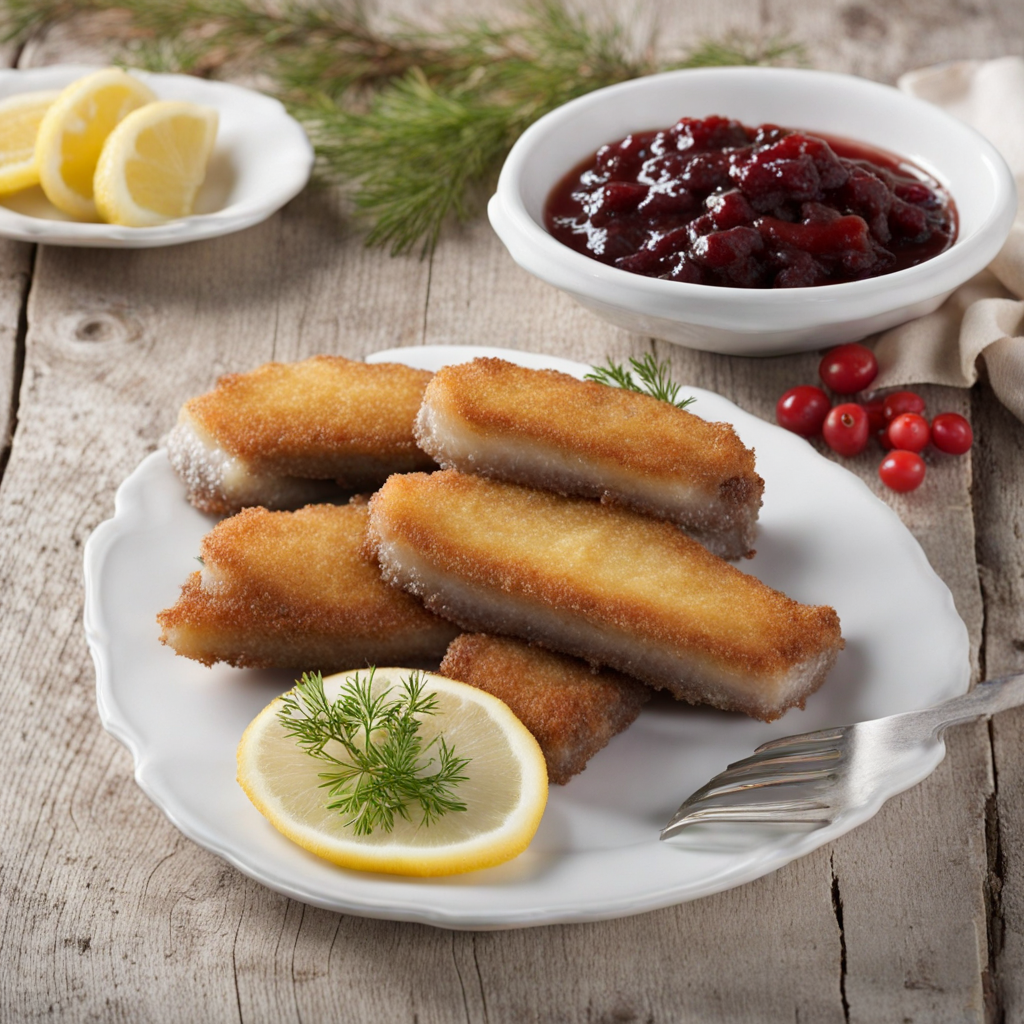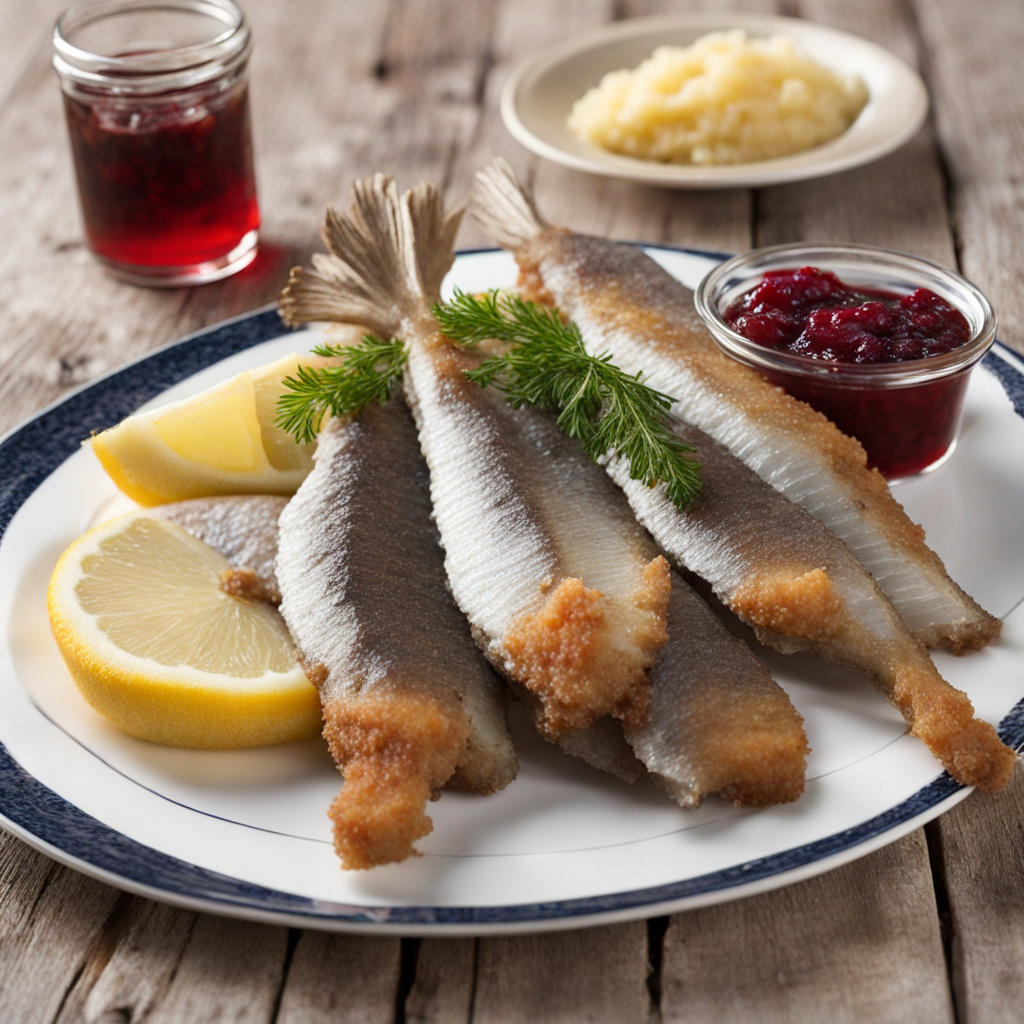Swedish Fried Herring
Swedish Fried Herring, known as "Stekt Sill" in Sweden, is a delightful seafood dish that showcases the country’s rich maritime heritage. This dish typically features herring fillets that have been marinated in a mixture of spices and vinegar, enhancing their natural flavor. The herring is then coated in a light dusting of flour or breadcrumbs before being pan-fried until golden brown and crispy. The result is a dish that offers an enticing contrast between the crunchy exterior and the tender, flavorful fish within, making each bite a savory experience. Traditionally, Swedish Fried Herring is often served with a variety of accompaniments that elevate its taste. Common pairings include creamy mashed potatoes, tangy lingonberry sauce, and a dollop of sour cream, which all work harmoniously to balance the richness of the fried herring. Additionally, it may be accompanied by pickled cucumbers or a fresh salad, which adds a crisp and refreshing element to the dish. The vibrant colors and diverse textures create an inviting presentation that is as pleasing to the eyes as it is to the palate. Enjoying Swedish Fried Herring is not just about the flavors; it’s about the experience of Swedish culture and tradition. This dish is often found in local restaurants and is a staple at festive gatherings, particularly during Midsummer celebrations. As you savor the herring, you are also indulging in a culinary history that reflects the importance of fish in Swedish cuisine, making it a must-try for anyone looking to explore new tastes and embrace the essence of Sweden.
How It Became This Dish
Stekt Strömming: A Culinary Journey Through Swedish History Stekt strömming, or fried herring, holds a special place in the hearts and kitchens of Sweden. This traditional dish, characterized by its crispy exterior and tender, flavorful fish inside, reflects not only the culinary practices of the region but also the broader socio-economic and cultural changes that have shaped Sweden over centuries. To truly appreciate stekt strömming, one must explore its origins, cultural significance, and evolution through history. Origins of Stekt Strömming The roots of stekt strömming can be traced back to the early days of Swedish fishing communities. Herring, known as strömming in Swedish, has been a staple fish in the Baltic Sea and the Gulf of Bothnia for centuries. The abundance of this fish made it a primary source of protein for coastal communities. Archaeological findings indicate that herring has been fished in Sweden since the Viking Age, with evidence suggesting that it was an essential part of the diet, preserved through salting and pickling techniques to extend its shelf life. In the 16th century, herring became a vital commodity in Sweden, particularly during the era of the Hanseatic League, a powerful trading alliance in Northern Europe. Swedish merchants traded salted herring with other nations, further embedding it into the nation’s culinary identity. The dish known as stekt strömming emerged as a practical way to prepare this abundant fish, showcasing local ingredients and simple cooking methods that were accessible to the average household. Cultural Significance Stekt strömming is more than just a dish; it represents a deep connection to Swedish cultural heritage. The preparation and consumption of herring have long been associated with traditional Swedish festivities and customs. For example, during Midsummer, one of Sweden's most cherished holidays, stekt strömming often finds its way onto the table alongside new potatoes, sour cream, and chives, symbolizing the arrival of summer and the bounty of the sea. Moreover, stekt strömming is often served during other festive occasions, such as Christmas and various regional celebrations. It embodies the concept of "lagom," the Swedish philosophy of moderation and balance, reflecting both a respect for nature's cycles and a sustainable approach to food consumption. The dish connects generations, as recipes are passed down through families, preserving not just the flavors but also the stories and traditions that accompany them. Development Over Time As Sweden moved through the centuries, the preparation of stekt strömming evolved alongside societal changes. The Industrial Revolution in the 19th century brought about significant advancements in food preservation and preparation. While traditional methods of cooking and preserving herring remained popular, new technologies allowed for more widespread distribution and accessibility of the fish. Canning became a viable method for preserving herring, making it available year-round rather than being restricted to seasonal catches. In the 20th century, as Sweden underwent urbanization and industrialization, the consumption patterns of stekt strömming began to shift. While rural communities continued to prepare the dish in traditional ways, urban dwellers sought convenience. The emergence of ready-to-eat meals and pre-packaged foods led to a decline in home-cooked meals, including stekt strömming. However, this shift also sparked a revival of interest in traditional foods, as many Swedes sought to reconnect with their culinary roots. The late 20th and early 21st centuries saw a renewed appreciation for traditional Swedish cuisine, fueled by a broader global interest in sustainability and local sourcing. Chefs and home cooks alike began to explore the nuances of Swedish culinary history, bringing dishes like stekt strömming back into the spotlight. This revival included a focus on high-quality ingredients, with an emphasis on sourcing herring from sustainable fisheries, as well as experimenting with different flavor profiles and preparation methods. Modern Interpretations Today, stekt strömming continues to be celebrated in Sweden and beyond, with various interpretations reflecting contemporary culinary trends. While the classic version involves simple breading and frying, modern chefs often incorporate innovative techniques and flavors. Some may serve it with a zesty remoulade or fresh herbs, while others may pair it with seasonal vegetables or unique sides that elevate the dish to new culinary heights. Moreover, stekt strömming has found its way into various restaurants and food festivals, showcasing the dish's versatility and ability to adapt to modern tastes. Food enthusiasts and tourists alike seek out authentic experiences, prompting local eateries to feature stekt strömming as a highlight of Swedish cuisine. Conclusion In conclusion, stekt strömming is more than just a dish; it is a reflection of Sweden's rich history, cultural heritage, and evolving culinary landscape. From its humble origins as a staple of coastal communities to its status as a beloved traditional dish enjoyed during celebrations, stekt strömming symbolizes the resilience and adaptability of Swedish cuisine. As it continues to evolve and inspire new generations of cooks and food lovers, stekt strömming remains a delicious testament to the enduring connection between food, culture, and history. Through each bite, one can taste not only the flavors of the sea but also the stories and traditions that have shaped the culinary identity of Sweden for centuries.
You may like
Discover local flavors from Sweden







